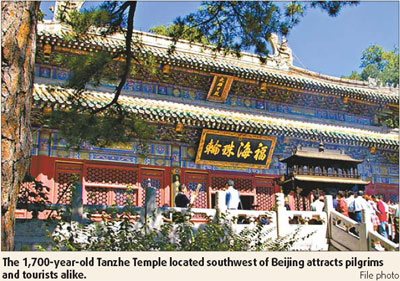Tourists flock to the temple of boom
Sitting outside the Tanzhe Temple under a 1,000-year old tree, Shun Xin feels a vibration in his pocket as his new mobile phone registers a text message.
"It's convenient," says the 60-year-old monk with a satisfied smile, looking at the trendy new device which he uses to discuss Buddhist sutra with believers and non-believers.
He even received a "Merry Christmas!" message like many other secular Chinese people.
"I know it's a festival but have no idea about its history and custom," he says.
Modern times have indeed caught up with the 1,700-year-old Buddhist temple some 40 kilometers southwest of Beijing. The temple predates the city by 800 years and both are being modernized. Therefore, a local saying goes that "first there was the founding of Tanzhe Temple, then the city of Beijing".
While Beijing is being renewed with glass and concrete buildings, monks at the Tanzhe Temple are happy enough to use modern communication devices to publicize their place of worship's 1,700th birthday.
Erected in AD 307 during the Western Jin Dynasty (AD 265-316), Tanzhe Temple is renowned for its close connections with the royal families of the Ming (1368-1644) and Qing (1644-1911) dynasties.
Having been through ups and downs over the dynasties and having survived the "cultural revolution" (1966-76) when many temples were destroyed, the Tanzhe Temple reopened to visitors in 1980.
This year the temple turns 1,700 years old and government officials are planning a series of celebrations including hosting a long-distance run in honor of the upcoming 2008 Beijing Olympics.
Hao Xinjian from the Tanzhe Temple administrative office says they hope to have 1,700 people take part in a long-distance run from southeast Beijing to the temple.
"The 1,700th anniversary is a good chance to promote the temple," Hao says.
The temple received 450,000 visitors last year up from 250,000 in 1998. The temple's profit in 2006, made from ticket sales, restaurants, souvenir shops, and incense and candle stores, was double what it was five years ago.
Hao says nowadays the Tanzhe Temple is more of a tourist spot than a place of worship, as many visitors, especially young people, are not Buddhists.
"The religious element and long history add to its mysterious atmosphere, which makes the spot more attractive to curious youngsters," he says.
Wang Yushan, an army officer, says he has visited the temple twice and liked the ancient buildings, melodious tolls of its bells and the quiet environment.
"I think many young people like me don't go there to make a pilgrimage, but to relax," Wang says.
Jing Luyan, a 22-year-old college student says she prayed for good health for her parents and a stable relationship with her boyfriend.
"I'm not a Buddhist, but making a wish in front of Buddha gives me self-confidence," Jing says.
She says that in the modern world, stressed-out city people need a place to relieve their pressures.
"We can preach to more people," Shun Xin says, agreeing that tourism has given the temple a boost.
But not everyone is happy with the influx of tourists. Another monk Chang Ren says too many visitors disturb the quietness and isolation monks need to rid themselves of desires according to the Buddhist doctrines.
(China Daily 05/24/2007 page19)














